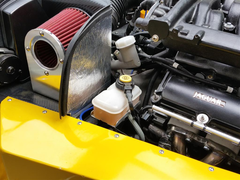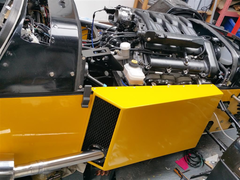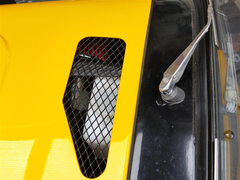bikecarbfred
|
| posted on 15/5/22 at 08:06 PM |

|
|
Manifold Heat Shield
Hi guys; i have a plastic air intake pipe routed from front grill to the airbox/ naturally aspirated Engine.
As you would guess the intake pipe is pretty near to the exhaust manifold but not close enough to melt it.
My question is very difficult and is regarding air temperature.
The intake pipe at the side of the engine is cool but as it nears the exhaust manifold it is "hot".
I am not sure how much cubic air an engine consumes every second but is air in the intake "long enough" for it's temperature to
rise?
Kind regards.
|
|
|
|
|
Slater
|
| posted on 15/5/22 at 09:26 PM |

|
|
Hello
Let make some assumptions:
1) 2.0 litre engine
2) Car is cruising at 2,000 rpm
3) Volume of air intake manifold 2 litre (same as big coke bottle)
So for every revolution of the engine, each cylinder goes up and down once, so 2 litres of air pass through every rev.
2,000 rpm x 2 litres = 4,000 litres of air per minute. or 66 litres per second.
2 litre intake volume / 66 litre per second = 0.03 seconds
So the air in your intake is only in there for 0.03 seconds.
I'd suggest this is not long enough for it to warm up via convection from the exhaust manifold.
Amazing how much air your car will use.
when pressing on, say at 6,000 rpm, it would use 12,000 litres per minute. Mind you only half of it gets mixed with fuel and exploded as the spark
only occurs every other stroke. But it would still use the 12,000 litres of air.
Hopefully that helps answer your question.
[Edited on 15-5-22 by Slater]
Why do they call Port Harcourt "The Garden City"?...... Becauase they can't spell Stramash.
|
|
|
bikecarbfred
|
| posted on 15/5/22 at 09:33 PM |

|
|
lol i was about to build a aluminum heatshield with an air gap and put some gold reflective tape on the pipe works.
wonder why people bother isf air is going through that fast.
i suppose if your at traffic the launch may suffer as the sitting air in the pipe may affect the first 0.01 second of the 0-60
|
|
|
adithorp
|
| posted on 15/5/22 at 10:38 PM |

|
|
Those figures are out. 4 stroke motor only draws its capacity every two revolutions.
"A witty saying proves nothing" Voltaire
http://jpsc.org.uk/forum/
|
|
|
Slater
|
| posted on 15/5/22 at 11:14 PM |

|
|
Yep, I thought about it some more and adithorp is correct, I'd forgotten about the valves staying closed on the squeeze and bang strokes
preventing the air from passing through. So we can half the air consumption above.
at 2,000 rpm the engine will use 2,000 litres/min
so air will be in the intake manifold for 0.06 seconds !!! Still not enough time to heat up.
Even at idle, or about 800 rpm, the engine will use 800 litres/min or 13 litres/second.
2 litre intake volume / 13 litres per sec = Only 0.15 seconds in the intake manifold.
[Edited on 16-5-22 by Slater]
Why do they call Port Harcourt "The Garden City"?...... Becauase they can't spell Stramash.
|
|
|
bikecarbfred
|
| posted on 16/5/22 at 04:50 AM |

|
|
Then why do they all wrap thier intakes and have manifolds shields to lower intake air. Even on the comments on YouTube clips and 100ís of forum posts
no one even mentions these facts. Are they all wasting
Money for nowt?
There was one guy claiming hp increase. If he had added the above formula to
His calculation he would have had to divide his answer by quite a lot
edit: i agree with the intake volume of 2 litres because that is probably the volume of the section of pipe that is very very hot around the
manifold.
I am not sure how heat dissipates throught the pipe; i.e air molecules ; how they attract heat off one n other.
but if you using a intake volume of 5 litres for the air box and 10 litres for the pipe work thats 15 litres;
15/15 at idle = 1 second the air is in there at all times.
can air heat up that quick? if the pipe is say 50 degree C how long does air in contact with that surface heat up per second.
[Edited on 16/5/22 by bikecarbfred]
Another edit: all those calculations i have done are wrong lol. ill leave it to the math guys haha; using 15 litres intake volume.
[Edited on 16/5/22 by bikecarbfred]
|
|
|
Mr Whippy
|
| posted on 16/5/22 at 06:45 AM |

|
|
Given that when the car is moving, the air is roaring into the engine bay and then rapidly swept out the back I don't think you'll be having
any problems.
|
|
|
40inches
|
| posted on 16/5/22 at 09:02 AM |

|
|
I have the intake air sensor just after the filter, the filter is isolated from the engine bay and the ally tube is wrapped in insulation.
The reported intake temp in slow moving traffic has been as high as 55 degrees c.
That's a 3 litre engine with vented side panels and bonnet top.
 
Description
 
Description
 
Description
|
|
|
snapper
|
| posted on 16/5/22 at 11:17 AM |

|
|
Under bonnet temperature is as much of an influence on intake temperature so I would say that a number of mitigations are needed to reduce heat
transfer.
I use heat shields with reflective material as you propose, and wrapped the exhaust manifold. I also use forced air from external ducts and vents to
let the hot air out.
The three methods of heat transfer are:
Conduction (something hot touching something less hot)
Convection (hot air or fluid transferring heat)
Radiation (transfer of heat via electromagnetic radiation, thing old electric fire) an exhaust can radiate as well as cause convection so wrapping it
and using heat shields reduces heat transfer.
Did you also know that the alternator draws cooling air through it from the rear and is often near the exhaust manifold, I used a heat shield and also
ducted cold air to the rear of the alternator.
I eat to survive
I drink to forget
I breath to pi55 my ex wife off (and now my ex partner)
|
|
|
bikecarbfred
|
| posted on 16/5/22 at 11:53 AM |

|
|
But why do all
Of this when the air is only in the intakes for max 0.6 seconds even at idle and there is not enough time to heat the air in all three ways as you
describe COMBINED.
Has t this all been a money making industry tactic : all the sales of gold wraps and heat shield materials .
I can just see oem
Use heatshieds for health and safety and not to cook the bonnet.
If the maths as slater suggest hold true then it is impossible for the heat to
Be transferre to the air travelling at this velocity in and out of engine.
I dont mind spending but I donít want to spend for cosmetic reasons lol
|
|
|
pigeondave
|
| posted on 16/5/22 at 12:25 PM |

|
|
How long is the air in a hair dryer in contact with the elements for. That air gets hot fairly quickly.
I think it also depends on where you're pulling the air from. It's it's truly from an out side source then you're as cool as you
can be. If it's from the engine bay behind the rad. You're getting at least rad warm air.
|
|
|
bikecarbfred
|
| posted on 16/5/22 at 12:45 PM |

|
|
quote:
Originally posted by pigeondave
How long is the air in a hair dryer in contact with the elements for. That air gets hot fairly quickly.
I think it also depends on where you're pulling the air from. It's it's truly from an out side source then you're as cool as you
can be. If it's from the engine bay behind the rad. You're getting at least rad warm air.
Great point about the hair dryer. Iíll have to see how they work
|
|
|
pigeondave
|
| posted on 16/5/22 at 12:59 PM |

|
|
quote:
Originally posted by Mr Whippy
Given that when the car is moving, the air is roaring into the engine bay and then rapidly swept out the back I don't think you'll be having
any problems.
Is that the case with a lot of cars? Ive seen studies which say that the air can be very stagnant in the engine bay. This is what typically causes
cooling issues with cars.
I believe that we'd all be surprised on how the air doesn't exist, unless you've done something to help it.
|
|
|
snapper
|
| posted on 16/5/22 at 04:20 PM |

|
|
quote:
Originally posted by bikecarbfred
But why do all
Of this when the air is only in the intakes for max 0.6 seconds even at idle and there is not enough time to heat the air in all three ways as you
describe COMBINED.
Has t this all been a money making industry tactic : all the sales of gold wraps and heat shield materials .
I can just see oem
Use heatshieds for health and safety and not to cook the bonnet.
If the maths as slater suggest hold true then it is impossible for the heat to
Be transferre to the air travelling at this velocity in and out of engine.
I dont mind spending but I donít want to spend for cosmetic reasons lol
You would need an inlet air temp sensor to know for sure but the simple calculation of 0.6 seconds transit speed doesnít address all the other factors
than need to be taken in to account.
I eat to survive
I drink to forget
I breath to pi55 my ex wife off (and now my ex partner)
|
|
|
Slimy38
|
| posted on 16/5/22 at 04:35 PM |

|
|
Most hair dryers have bigger intakes than exhausts, a much slower wind speed compared to an engine, as well as a fairly open body to slow down the air
and keep it in contact with the element a lot longer. You're also talking about an element that has a huge surface area (a very long coiled wire)
and is usually glowing red for the time it's on. It's also being actively heated by electricity, not passively warmed by external drivers.
Turn the element off on a hair dryer and it'll be blowing cold air in seconds.
Heat shields in place so it's not directly sucking in warm air is a proven thing. Gulping on large amounts of under-bonnet hot air after sitting
at lights for a while, yep I can see that being an issue for the first few seconds. Even driving hard on a hot day can make a car feel sluggish. But
despite a fair few minutes on Google, I'm not convinced manifold wrapping can do anything noticeable.
[Edited on 16/5/22 by Slimy38]
[Edited on 16/5/22 by Slimy38]
|
|
|
bikecarbfred
|
| posted on 16/5/22 at 04:40 PM |

|
|
Well then why even bother with a manifold
Heat shield when the actually air filter sucking cold
Air from outside. I think I need to find some
Proper studies into this.
|
|
|
pigeondave
|
| posted on 16/5/22 at 04:47 PM |

|
|
quote:
Originally posted by bikecarbfred
I think I need to find some
Proper studies into this.
Let us know what you find. It's a rabbit hole which I've managed to avoid
|
|
|
gremlin1234
|
| posted on 16/5/22 at 05:46 PM |

|
|
heat shields are certainly required if you have a carb just above the exhaust manifold, else fuel will 'boil' in the float chamber.
|
|
|
bikecarbfred
|
| posted on 16/5/22 at 08:03 PM |

|
|
okay so then...
why is it when..
stood still the intake pipe gets very very hot, then when driving the pipe is not as hot. that must mean the cold air has transfered heat. It must
have carried that heat transfer into the engine.
the question is how long did it take to cool down the pipe.
if it took a while then what you say is correct and that air is being used to quickly by the engine for any gold intake wrap to make any difference
to air temperture.
if it takes literually a few seconds for the temp of the pipe to drop then surely air is being warmed up by hot pipes and conveyed into the engine.
EDIT: Holy moly just googled "intake wraps make a difference" and there is literially tons of forum posts/questions on this topic.
seems like a lot to read now for me 
[Edited on 16/5/22 by bikecarbfred]
|
|
|
bikecarbfred
|
| posted on 16/5/22 at 08:48 PM |

|
|
been doing a bit more reading.. seems like it can effect the launch.
the initial launch will include the first bit of the hot air in the intake.
if the initial first second of the launch requires 60 litres of air and 10 litres of that which was stored in the pipe is 10C hotter in idle due to
the heat from the manifold then thats 1/6 , probs overall 2C cooler for that first second.
What's that going to do with 0-60? lol
|
|
|
snapper
|
| posted on 17/5/22 at 05:51 AM |

|
|
This feels like a massive ďover thinking itĒ post, I thought part of the problem was that the air feed pipe was plastic and could melt near the
exhaust manifold.
SolutionÖ fit heat shield, vent under bonnet heat. A simple piece off ally with some cheap silvered heat mat will do the job.
Cold air feed to the carb/engine does help as the air charge is more dense and contains more O2, thatís physics and I have recently seen this for
myself with dyno results for one of my engines when the dyno cell was very cold for the first couple of hours.
Focusing on just the charge air temp, which you have not measured, misses all the other factors that transfer heat in an engine.
A cool engine performs better than a hot one so coolant temp affects performance but conversely oil needs to be about 90 degrees to reduce parasitic
losses. The downside of a cool engine is increased emissions and possible condensate in the oil.
I eat to survive
I drink to forget
I breath to pi55 my ex wife off (and now my ex partner)
|
|
|
bikecarbfred
|
| posted on 17/5/22 at 06:23 AM |

|
|
We are talking about the time
Air is In the tubing and in the intake. If it is in long enough for any heat soak to take place while driving . Thanks
|
|
|
bikecarbfred
|
| posted on 17/5/22 at 07:57 PM |

|
|

This is the main front grill BETWEEN the headlights.
Would air bounce hot air off radiator into the intake air filter via swirl
|
|
|
pigeondave
|
| posted on 17/5/22 at 10:05 PM |

|
|
Air is lazy.
You wont be getting as much air as you could through that rad as there is no side plates to the rad.
The air will hit the rad and spill to the sides (path of least resistance)
|
|
|
bikecarbfred
|
| posted on 18/5/22 at 06:11 AM |

|
|
So when lazy air hits rad: does it bounce off hot air from
It and swirl around in that compartment for it to be sucked in my engine.
Please not this section is not part of the (edit: engine ) bay where it is very hot. Itís the grill section
[Edited on 18/5/22 by bikecarbfred]
|
|
|













